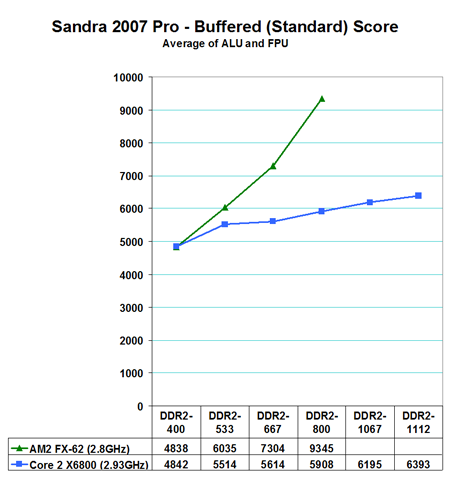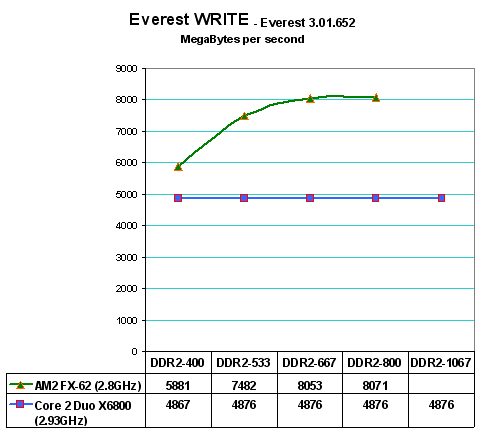Memory Bandwidth and Scaling
Everyone should already know that memory bandwidth improves with increases in memory speed and reductions in memory timings. To better understand the behavior of AM2 and Core 2 Duo memory bandwidth we used SiSoft Sandra 2007 Professional to provide a closer look at memory bandwidth scaling.

The most widely reported Sandra score is the Standard or Buffered memory score. This benchmark takes into account the buffering schemes like MMX, SSE, SSE2, SSE3, and other buffering tools that are used to improve memory performance. As you can clearly see in the Buffered result the AM2 on-chip memory controller holds a huge lead in bandwidth over Core 2 Duo. At DDR2-800 the AM2 lead in memory bandwidth is over 40%.
As we have been saying for years, however, the Buffered benchmark does not correlate well with real performance in games on the same computer. For that reason, our memory bandwidth tests have always included an UNBuffered Sandra memory score. The UNBuffered result turns off the buffering schemes, and we have found the results correlate well with real-world performance.

The Intel Core 2 Duo and AMD AM2 behave quite differently in UNBuferred tests. In these results AM2 and Core2 Duo are very close in memory bandwidth - much closer than in Standard tests. Core 2 Duo shows wider bandwidth below DDR2-800, but this will likely change when the AM2 controller matures and supports values below 3 in memory timings as the Core 2 Duo currently supports.
The Sandra memory score is really made up of both read and write operations. By taking a closer look at the Read and Write components we can get a clearer picture of how the two memory controllers operate. Everest from Lavalys provides benchmarking tools that can individually measure Read and Write operations.

The READ results are particularly interesting, since you can see that the READ component of Core 2 Duo performance is much larger than the WRITE results on Core 2 Duo. This is the result of the intelligent read-aheads in memory which Intel has used to lower the apparent latency of memory on the Core 2 Duo platform. Actual READ performance on Core 2 Duo now looks almost the same as AM2 to DDR2-533. AM2 starts pulling away in READ at DDR2-677 and has a slightly steeper increase slope as memory speed increases. The increases in READ speed in Core 2 Duo are a result of the intelligent read-aheads in memory. Performance without this feature would show Core 2 Duo much slower in READ operations than AM2.

This is most clearly illustrated by looking at Everest Write scores. Memory read-ahead does not help when you are writing memory, so core 2 Duo exhibits much lower WRITE performance than AM2 as we would expect. This means if all else were equal (and it isn't) the AM2 would perform much better in Memory Write tasks. Surprisingly the WRITE component of Core 2 Duo appears a straight line just below 5000 MB/s. AM2 starts at 5900 at DDR2-400 and WRITE rises to around 8000MB/s at DDR2-667. Write then appears to level off, with higher memory speeds having little to no impact on AM2 WRITE performance.
Everyone should already know that memory bandwidth improves with increases in memory speed and reductions in memory timings. To better understand the behavior of AM2 and Core 2 Duo memory bandwidth we used SiSoft Sandra 2007 Professional to provide a closer look at memory bandwidth scaling.

The most widely reported Sandra score is the Standard or Buffered memory score. This benchmark takes into account the buffering schemes like MMX, SSE, SSE2, SSE3, and other buffering tools that are used to improve memory performance. As you can clearly see in the Buffered result the AM2 on-chip memory controller holds a huge lead in bandwidth over Core 2 Duo. At DDR2-800 the AM2 lead in memory bandwidth is over 40%.
As we have been saying for years, however, the Buffered benchmark does not correlate well with real performance in games on the same computer. For that reason, our memory bandwidth tests have always included an UNBuffered Sandra memory score. The UNBuffered result turns off the buffering schemes, and we have found the results correlate well with real-world performance.

The Intel Core 2 Duo and AMD AM2 behave quite differently in UNBuferred tests. In these results AM2 and Core2 Duo are very close in memory bandwidth - much closer than in Standard tests. Core 2 Duo shows wider bandwidth below DDR2-800, but this will likely change when the AM2 controller matures and supports values below 3 in memory timings as the Core 2 Duo currently supports.
The Sandra memory score is really made up of both read and write operations. By taking a closer look at the Read and Write components we can get a clearer picture of how the two memory controllers operate. Everest from Lavalys provides benchmarking tools that can individually measure Read and Write operations.

The READ results are particularly interesting, since you can see that the READ component of Core 2 Duo performance is much larger than the WRITE results on Core 2 Duo. This is the result of the intelligent read-aheads in memory which Intel has used to lower the apparent latency of memory on the Core 2 Duo platform. Actual READ performance on Core 2 Duo now looks almost the same as AM2 to DDR2-533. AM2 starts pulling away in READ at DDR2-677 and has a slightly steeper increase slope as memory speed increases. The increases in READ speed in Core 2 Duo are a result of the intelligent read-aheads in memory. Performance without this feature would show Core 2 Duo much slower in READ operations than AM2.

This is most clearly illustrated by looking at Everest Write scores. Memory read-ahead does not help when you are writing memory, so core 2 Duo exhibits much lower WRITE performance than AM2 as we would expect. This means if all else were equal (and it isn't) the AM2 would perform much better in Memory Write tasks. Surprisingly the WRITE component of Core 2 Duo appears a straight line just below 5000 MB/s. AM2 starts at 5900 at DDR2-400 and WRITE rises to around 8000MB/s at DDR2-667. Write then appears to level off, with higher memory speeds having little to no impact on AM2 WRITE performance.










118 Comments
View All Comments
Coogcheese - Tuesday, July 25, 2006 - link
Is the latency issue really due to intelligent look-ahead or the vast cache size difference between the two processors? I'd like to see a benchmark comparison between an 2MB cache opeteron and an equally cached/clocked/timed Conroe. That would settle some debate (yea, yea...wishful thinking).It could also help lend some insite to what AMD might do in the short & long term as a response as well.
The author of the review seems to give alot of credit to "look-ahead" but I found this benchmark comparison to be interesting: http://www.hexus.net/content/item.php?item=6256&am...">http://www.hexus.net/content/item.php?item=6256&am...
Opteron doesn't seem to have same problem that the Athlon does in terms of latency performance. Which could be why amd execs seem less than panicky at this point. It would allude to a market war similar to the megahurtz war that led to amd coming out with the model # system...this time it could be intel taking advantage of their capacity by laying the cache size smack down on amd instead of megahurtz.
If it is cache size and not "look-ahead" then amd could (could mind you...but would they? and how many could they?) respond much quicker I'd think. If its new technology or a combo of cache and new tech then amd will be in a much worse position imho.
Whatever the case its great for the consumer(me). Thank goodness for competition. Daddy needs a new pair of cores...and the price just got a whole lot better!
ChronoReverse - Tuesday, July 25, 2006 - link
It would indeed be very interesting to see a 2MB L2 1.6GHz Core 2 Duo E6200 compared against 2MB L2 1.6GHz Opteron 160.The shared L2 cache of the Conroe will give it a nice advantage though.
bob661 - Tuesday, July 25, 2006 - link
Anyonehave any speculation as to how much the initial Conroe's will cost? We pretty much know that the motherboards will be expensive but what about the CPU's?ChronoReverse - Tuesday, July 25, 2006 - link
The pricing has been out for a while already. They're relatively reasonable considering the performance. Only the Extreme Edition as usual is really expensive (but still not as expensive as I'd have thought).Too bad the motherboards are so expensive. I'm taking a look at that Asrock board, but I doubt it'll have any good overclocking capability.
Gary Key - Tuesday, July 25, 2006 - link
The less expensive boards for Conroe will fully hit the market near the end of August. ;-) We expect to see ECS, Foxconn, MSI, Epox, and others fully ramped up in a couple of weeks on the value boards. Until then, the Gigabyte DS3 is a really good board for overclocking the E6300/E6400 series and our Biostar and Abit boards continue to improve with each bios release. All three are under $145 now with others joining them shortly if the P965 is interesting to you. The ASRock board actually surprised us, but remember the VCore voltage cannot be adjusted. The $50~$100 market will be very interesting as the 945P, 946PL, and NV570SLI chipsets will dominate this section until the G965 boards start arriving in September if decent intergrated graphics are on your wish list, if not all of the boards will offer good performance for the money. The under $55 market will consist of VIA and SIS chipsets from PC-Chips and ASRock with a few majors like ECS and MSI having boards based on these chipsets.
Wesley Fink - Tuesday, July 25, 2006 - link
Everest Scores have been rerun with Version 3.01, which was released on July 16, 2006. Since the scores from the new version can not be compared to older Everest scores, we reran all the Everest benchmarks. 3.01 is said to provide full and complete support for Conroe and Merom. Values are different in that Memory WRITE and READ scores are reported as much higher than past Everest testing. Latency is also reported as closer between AM2 and Core 2 Duo with the 3.01 version of Everest. Charts and commentary have been revised using the new results.jjunos - Tuesday, July 25, 2006 - link
Thanks for the update wes! It always shows the quality of the website when they listen to their community and and willing to rerun all their tests in the sake of being correct! kudos!TonyB - Tuesday, July 25, 2006 - link
is it just me or did AMD just get pwned?bob661 - Tuesday, July 25, 2006 - link
I personally don't care about who owns who. I just want competition so I can get this stuff for cheap. I'm a best bang for the buck guy.goinginstyle - Tuesday, July 25, 2006 - link
Everyone benefits here with the performance improvements Intel has brought to the table and an AM2 3800+ at $150 is just an incredible value. Conroe made it easy for AMD users to upgrade their performance for very little money.